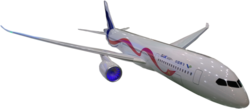CRAIC CR929
| CRAIC CR929 | |
|---|---|

|
|
| Type: | Twin-engine wide-body aircraft |
| Design country: | |
| Manufacturer: | |
| First flight: |
planned for 2025 |
| Commissioning: |
planned from 2027 |
| Production time: |
planned from 2027 |
The CRAIC CR929 (originally Comac C929 , then CRAIC C929 ) is a planned twin- engine wide - body aircraft for medium or long-haul flights with two gears ( English twin aisle ) in probably three versions CR929-500 , CR929-600 and CR929-700 and a range of up to to 12,000 kilometers; the first flight is scheduled to take place in 2025 . The aircraft is in the segment of Airbus A330 , A350 and Boeing 787 / 767 are placed.
Distribution of production
The aircraft is being built by the Sino-Russian joint venture China-Russia Commercial Aircraft International Company (CRAIC). The aircraft is designed at UAC . The wings, engine mounts and cowlings are built by UAC, the stern and fuselage by COMAC. The final assembly is to take place in Shanghai.
By-pass engines from Rolls-Royce or General Electric are planned as engines for the first series aircraft . Later production series (around 2030) are to receive Russian or Chinese engines. The Russian engines are to be derived from the Awiadwigatel PD-14 , have a thrust of about 340 to 390 kN and are called PD-35. The Chinese side wants to develop its own CJ-2000 engines in this performance class, which Russian experts view with a certain degree of skepticism, given the fact that so far only western manufacturers have offered engines for wide-body aircraft with more than 340 kN thrust and China has not yet offered any Has experience and technology in this field.
Technical specifications
| Parameter | CRAIC CR929 |
|---|---|
| length | 63.25 m |
| span | 55.60 m |
| height | 13.50 m |
| Hull diameter | 5.92 m |
| Seats | 280-350 |
| Max. Takeoff mass | 220,000 kg |
| Cruising speed | k. A. |
| Range | 12,000 km |
| Engines | k. A. |
| power | approx. 340-390 kN each |
| Takeoff route | k. A. |
| Landing route | k. A. |
Some of this information is provisional and has not been confirmed. They should give an idea of the size of the project.
Naming
The designation "CR929" essentially corresponds to the naming logic of COMAC . "C" stands for (the People's Republic of) C who finds himself hina in the second "C" Company of the company Comac; At the same time, this implies a closeness to the two major manufacturers Airbus and Boeing in the sense of an equal ABC . The "R" stands for R ussia. Numbers play an important role in Chinese culture. Accordingly, the first digit “9” represents eternity (Chinese 永恒 yǒnghéng). The last two digits “29” stand for “290”, the planned maximum number of seats for the model, as do the numbers “19” for the 190 seats on the Comac C919 .
See also
Web links
- Information on the CRAIC CR929 ("Wide Body") on the manufacturer's website
Individual evidence
- ↑ CR929 will probably be larger than Airbus A330-900 , accessed on June 1, 2016
- ↑ Project name C929: Russians and Chinese to build together a wide-body aircraft , ingenieur.de 21 November 2016th
- ↑ Mockup of Sino-Russian long-range widebody aircraft debuts , Comac, November 2, 2016.
- ↑ Timo Nowack: Russian-Chinese long-haul jet: First impressions of the cabin of the C929. In: aerotelegraph.com. June 30, 2017. Retrieved July 1, 2017 .
- ↑ a b Jeffrey Lin, PW Singer: China and Russia are teaming up to create the next generation of jumbo jet. In: popsci.com. June 5, 2017, accessed July 1, 2017 .
- ↑ Planned jet: Russia and China want to jointly outpace Boeing and Airbus. In: de.sputniknews.com. December 19, 2016, accessed July 1, 2017 .
- ↑ Swilen Petrow: China, Russia formalize Partnership to Build Wide-Body Commercial Jet. In: wingsjournal.com. June 6, 2017, accessed July 1, 2017 .
- ↑ Chen Chuanren, Charles Alcock: Service Entry For C919 Remains Uncertain After First Flight. In: ainonline.com. June 15, 2017, accessed July 1, 2017 .
- ^ Moscow starts developing heavy engine for joint Chinese-Russian airliner. In: tass.com. June 20, 2016, accessed July 1, 2017 .
- ↑ a b Wladimir Karnosow: Russia and China push for next-generation widebody. In: ainonline.com. June 11, 2015, accessed July 1, 2017 .
- ↑ Кто будет играть первую скрипку в проекте ШФДМС. In: aviation21.ru. April 1, 2017, Retrieved July 1, 2017 (Russian).
- ↑ Suppliers wanted for wide-body passenger airplane , China Daily November 8, 2014
- ↑ New details emerge on proposed China-Russia widebody , accessed June 1, 2018